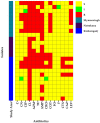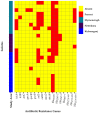Phenotypic and Genotypic Characteristics of Antimicrobial Resistance in Citrobacter freundii Isolated from Domestic Ducks (Anas platyrhynchos domesticus) in Bangladesh
- PMID: 37107131
- PMCID: PMC10135275
- DOI: 10.3390/antibiotics12040769
Phenotypic and Genotypic Characteristics of Antimicrobial Resistance in Citrobacter freundii Isolated from Domestic Ducks (Anas platyrhynchos domesticus) in Bangladesh
Abstract
Antimicrobial resistance (AMR) in Citrobacter freundii poses a serious challenge as this species is one of the sources of nosocomial infection and causes diarrheal infections in humans. Ducks could be the potential source of multidrug-resistant (MDR) C. freundii; however, AMR profiles in C. freundii from non-human sources in Bangladesh have remained elusive. This study aimed to detect C. freundii in domestic ducks (Anas platyrhynchos domesticus) in Bangladesh and to determine their phenotypic and genotypic antibiotic susceptibility patterns. A total of 150 cloacal swabs of diseased domestic ducks were screened using culturing, staining, biochemical, polymerase chain reaction (PCR), and matrix-assisted laser desorption/ionization time-of-flight (MALDI-TOF) to detect C. freundii. Phenotypic and genotypic antibiotic susceptibility patterns were done by the disk diffusion method and PCR, respectively. In total, 16.67% (25/150) of the samples were positive for C. freundii. C. freundii isolates showed a range of 20% to 96% resistance to cefotaxime, gentamicin, levofloxacin, ciprofloxacin, cotrimoxazole, tetracycline, ampicillin, and cephalexin. More than 60% of the isolates were phenotypically MDR, and the index of multiple antibiotic resistance ranged from 0.07 to 0.79. Genes encoding resistance to beta-lactams [blaTEM-1-88% (22/25), blaCMY-2-56% (14/25), blaCMY-9-8% (2/25), and blaCTX-M-14-20% (5/25)], sulfonamides [sul1-52% (13/25), sul2-24% (6/25)], tetracyclines [tetA-32% (8/25) and tetB-4% (1/25)], aminoglycosides [aacC4-16% (4/25)], and fluoroquinolones [qnrA-4% (1/25), qnrB-12% (3/25), and qnrS-4% (1/25)] were detected in the isolated C. freundii. To the best of our knowledge, this is the first study in Bangladesh to detect MDR C. freundii with their associated resistance genes from duck samples. We suggest addressing the burden of diseases in ducks and humans and associated AMR issues using the One Health approach.
Keywords: Bangladesh; C. freundii; antimicrobial resistance; ducks; multidrug resistance; public health; resistance genes.
Conflict of interest statement
The authors declare no conflict of interest.
Figures



References
-
- Tawyabur M., Islam M., Sobur M., Hossain M., Mahmud M., Paul S., Hossain M.T., Ashour H.M., Rahman M. Isolation and characterization of multidrug-resistant Escherichia coli and Salmonella spp. from healthy and diseased turkeys. Antibiotics. 2020;9:770. doi: 10.3390/antibiotics9110770. - DOI - PMC - PubMed
-
- Wang J.T., Chang S.C. Citrobacter Species. 2016. [(accessed on 25 February 2023)]. Available online: http://www.antimicrobe.org/b93.asp.

